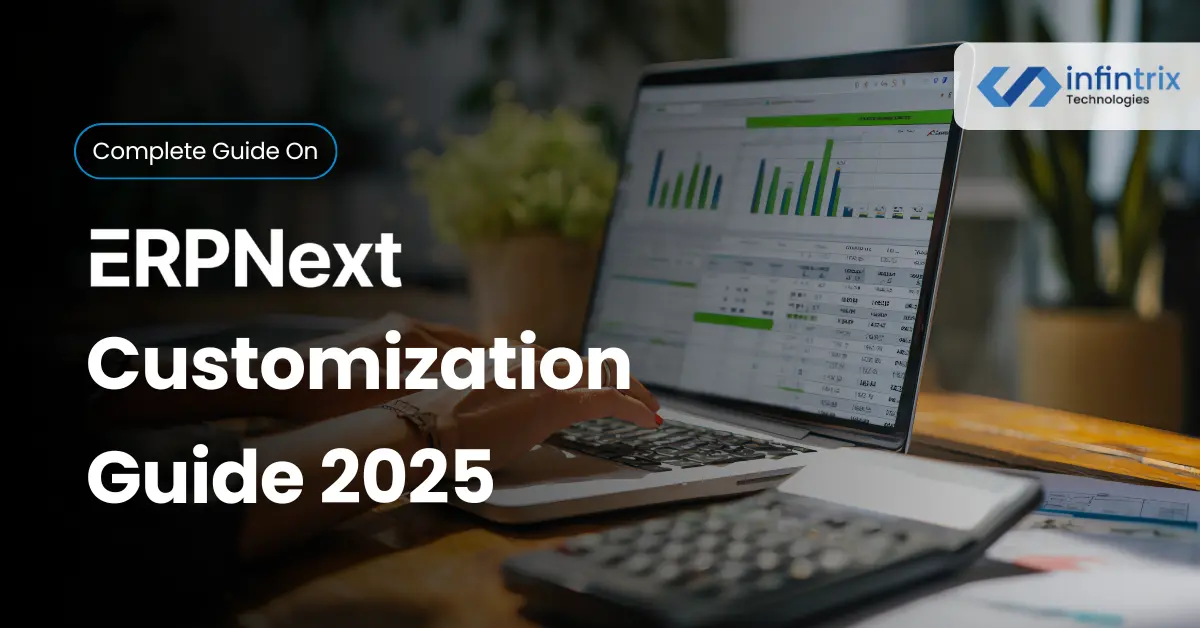Every business wants its ERP system to feel like a perfect fit — flexible enough to support unique workflows, yet stable enough to run without disruption. ERPNext, being open-source and built on the Frappe Framework, makes this possible through extensive customization options.
But here’s the catch: not every business needs to customize ERPNext, and not every customization adds value. Sometimes, what looks like a smart improvement today can create a maintenance burden or block future upgrades.
This ERPNext customization guide helps you understand when to customize ERPNext — and when to rely on its standard features. Think of it as your playbook for making customization decisions that serve long-term strategy, not short-term preference.
What ERPNext Customization Actually Means (and Why It Matters)
In simple terms, customizing ERPNext means changing or extending its core functionality to meet your unique business requirements. It can range from small tweaks like adding custom fields to building entirely new custom apps.
However, it’s important to distinguish customization from configuration — a difference many teams overlook. Configuration uses ERPNext’s built-in tools and settings to adjust workflows without touching the core code. Customization, on the other hand, modifies or adds new logic to the system.
ERPNext Customization vs. Configuration — Key Differences
| Aspect | Configuration | Customization |
| What it involves | Adjusting settings, permissions, and workflows | Writing code or scripts to add or modify features |
| Example | Setting approval hierarchies or custom print formats | Creating new DocTypes or automating logic via server scripts |
| Impact | Safe and upgrade-compatible | Requires testing and careful version management |
When done right, customization helps tailor ERPNext to your processes without compromising upgrade compatibility. When done wrong, it can create future problems — especially if it changes the core behavior of standard modules.
Common Areas Where Businesses Customize ERPNext
Many businesses choose to customize ERPNext for functions where standard tools fall short. Examples include:
- HR & Payroll: Adjusting attendance or overtime calculations.
- Manufacturing: Adding machine-level scheduling logic.
- Retail: Customizing the POS interface for local taxation rules.
- Service-based firms: Automating recurring billing or time tracking.
These targeted improvements can drive efficiency — but they must be planned with upgrade safety in mind.
Why (and When) You Should Customize ERPNext
Customization is powerful when it supports your business needs and aligns with your operational goals. In some cases, out-of-the-box features don’t fit your industry’s complexity — and that’s when customizing ERPNext makes real sense.
For example, a manufacturer with multi-stage quality inspections may need custom workflows that the standard ERPNext setup doesn’t provide. Similarly, a healthcare organization might need specialized patient data forms using Custom DocTypes and Custom Scripts.
Aligning ERPNext With Unique Business Processes
If your business process doesn’t map cleanly to ERPNext’s structure — say, you manage multi-location approvals or complex supplier chains — customization helps bridge the gap. The key is ensuring these changes simplify operations rather than overcomplicate them.
Improving Efficiency and User Experience
Small, focused customizations can eliminate friction in daily operations. For instance:
- Automating repetitive approvals using Server Scripts.
- Creating dashboards that show actionable KPIs.
- Designing print formats that save manual formatting time.
Each improvement compounds productivity and makes ERPNext easier to adopt across departments.
Scaling Operations as the Business Grows
As your organization expands, you may integrate ERPNext with CRMs, eCommerce platforms, or IoT systems. Custom apps and API integrations make this growth seamless. When customization scales strategically, it becomes a growth enabler — not a liability.
When You Shouldn’t Customize ERPNext (and What to Do Instead)
Just because you can customize ERPNext doesn’t always mean you should. Too many changes can increase the risk of errors, slow down upgrades, or create reliance on developers who know your custom code.
In most cases, businesses benefit from exploring configuration and extensions first — options that meet 80–90% of requirements without touching the core functionality.
Warning Signs Customization Might Backfire
| Symptom | Risk |
| Customizations duplicate existing features | Redundant effort, wasted cost |
| Changes directly modify core code | Upgrade compatibility issues |
| Lack of documentation | High maintenance burden |
| Dependence on one developer | Continuity risk if expertise leaves |
These signs often appear after rushed or poorly scoped projects — especially when decisions are made without consulting ERP experts.
Smarter Alternatives: Configuration, Extensions, and Integrations
Before writing a single line of code, consider these safer paths:
- Use Workflows, Custom Fields, and Reports to match your business process.
- Explore existing Frappe Framework apps or ERPNext extensions.
- Integrate external systems through APIs instead of modifying ERPNext modules directly.
That way, you retain flexibility while staying aligned with ERPNext’s standard upgrade path.
How to Customize ERPNext the Right Way
When customization becomes necessary, following a structured approach ensures your changes remain stable, upgrade-safe, and maintainable. ERPNext gives developers incredible flexibility, but that power must be balanced with discipline.
Here’s a recommended process that seasoned ERP consultants (and companies like Infintrix Technologies) often follow during ERPNext customization projects:
1. Define the Real Need First
Every customization should start with a clear business objective — not just a feature request.
Ask:
- What business problem are we solving?
- Does ERPNext already have a configuration for this?
- Is there an existing app or module that achieves this goal?
Only after confirming a real gap should you proceed to customization.
2. Use Frappe Framework Tools Smartly
ERPNext’s underlying Frappe Framework offers developer-friendly tools like:
- Custom DocTypes for new data structures
- Server Scripts and Client Scripts for logic automation
- Custom Apps for isolated modules that won’t affect core updates
By keeping all custom logic inside a custom app (instead of editing the ERPNext core), you preserve upgrade compatibility and maintain clean separation of concerns.
3. Keep Documentation and Version Control Mandatory
Documenting every change is non-negotiable. Use Git for version control and maintain a simple README that describes:
- Why the customization exists
- Which modules it affects
- How to test or revert it
This ensures your team — or future developers — can maintain the system confidently.
4. Test Extensively Before Deployment
Always create a staging environment to test your customizations. This step helps detect conflicts, broken dependencies, or UI errors before impacting production.
A well-tested deployment avoids the classic “it worked on my machine” problem that plagues ERP projects.
The Real Cost and Commitment Behind ERPNext Customization
ERPNext is open source, but customization isn’t free — not in terms of time, testing, or maintenance. Each modification introduces ongoing technical debt that needs to be managed.
Here’s what to factor in before approving any customization:
1. Development & Testing Costs
Even simple features require developer hours, QA testing, and documentation.
For larger projects (e.g., new modules or integrations), these costs scale quickly.
2. Upgrade & Maintenance Costs
ERPNext releases frequent updates. Custom code can break after major version changes unless it’s maintained regularly.
Budget not only for development but for long-term upkeep.
3. Opportunity Cost
Complex customizations can delay other strategic initiatives. It’s better to prioritize features that directly drive productivity or compliance — and postpone “nice-to-have” ones.
A trusted ERP partner like Infintrix Technologies helps businesses strike this balance — customizing only where it creates measurable business value while keeping systems upgrade-ready.
Making the Right Choice — Customize or Configure?
When deciding whether to customize ERPNext, use this simple framework:
| Question | If “Yes,” Consider Customization | If “No,” Use Configuration |
| Does the process create unique business value? | ✅ | |
| Can ERPNext’s standard tools handle 80% of it? | ✅ | |
| Does it require automation beyond workflows or reports? | ✅ | |
| Will it affect future upgrades? | ❌ Rethink customization | ✅ Safe to configure |
Practical Rule of Thumb
If it changes business logic, customize carefully.
If it changes business visibility or flow, configure confidently.
When in doubt, consult ERP experts — especially certified partners like Infintrix Technologies, who can evaluate your requirements and recommend a sustainable path.
Conclusion — Customization Is a Strategy, Not a Shortcut
ERPNext customization, when guided by business logic and technical discipline, transforms the system into a perfect operational fit.
But the secret lies in restraint — customize only where it truly adds measurable value.
With structured planning, version control, and expert guidance, your ERPNext system remains scalable, upgrade-friendly, and efficient for years to come.
That’s why working with experienced ERP specialists such as Infintrix Technologies isn’t just about development — it’s about ensuring your ERPNext grows with your business, not against it.
FAQs About ERPNext Customization
Q1. Is ERPNext customization safe during version upgrades?
Yes, if you use custom apps instead of editing ERPNext’s core files. Partners like Infintrix Technologies follow upgrade-safe customization practices using the Frappe Framework.
Q2. How much does ERPNext customization cost?
It varies by complexity. Simple field additions might cost little, while complex workflow automation or integrations require dedicated development hours.
Q3. Can non-developers perform customization?
Basic configuration (like adding fields or workflows) can be done by administrators. However, coding-level customizations should be handled by skilled Frappe or ERPNext developers.
Q4. Should startups customize ERPNext early on?
Usually not. Early customization can add unnecessary complexity. Start with configuration and introduce custom features only when your processes stabilize.
Q5. What’s the best way to ensure customization success?
Plan thoroughly, document every change, test in staging, and work with a reliable ERPNext partner like Infintrix Technologies to keep your system optimized and upgrade-safe.

